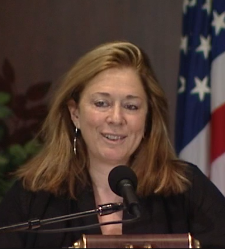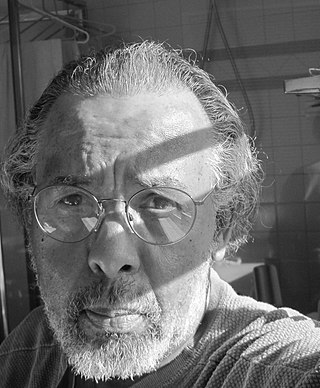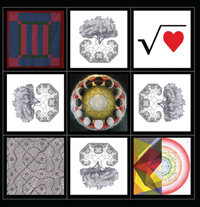Related Research Articles
Frank C. Moore II was a New York-based painter, winner of the Logan Medal of the Arts, and a member of the Visual AIDS Artist Caucus—the organization responsible for the (Red) Ribbon Project, A Day Without Art, and A Night Without Light.

William Lewis is an English artist, story-teller, poet and mythographer. He was a founder-member of The Medway Poets and of the Stuckists art group.

Jorie Graham is an American poet. The Poetry Foundation called Graham "one of the most celebrated poets of the American post-war generation." She replaced poet Seamus Heaney as Boylston Professor of Rhetoric and Oratory at Harvard University, becoming the first woman to be appointed to this position. She won the Pulitzer Prize for Poetry (1996) for The Dream of the Unified Field: Selected Poems 1974-1994 and was chancellor of the Academy of American Poets from 1997 to 2003. She won the 2013 International Nonino Prize in Italy.
Richard Dean Tuttle is an American postminimalist artist known for his small, casual, subtle, intimate works. His art makes use of scale and line. His works span a range of formats, from sculpture, painting, drawing, printmaking, and artist’s books to installation and furniture. He lives and works in New York City, Abiquiú, New Mexico, and Mount Desert, Maine.
The University of Georgia Press or UGA Press is the university press of the University of Georgia, a public land-grant research university with its main campus in Athens, Georgia. It is the oldest and largest publishing house in Georgia and a member of the Association of University Presses.
Pierre Coupey is a Canadian painter, poet, and editor.
Foetry.com, sometimes referred to as just Foetry, was a website that attempted to identify fraudulent and unethical practices in poetry contests. It was active from April 1, 2004 until May 18, 2007.
Kim Dingle is a Los Angeles-based contemporary artist working across painting, sculpture, photography, found imagery, and installation. Her practice explores themes of American culture, history, and gender politics through both figurative and abstract approaches.

Susan Charna Rothenberg was an American contemporary painter, printmaker, sculptor, and draughtswoman. She became known as an artist through her iconic images of the horse, which synthesized the opposing forces of abstraction and representation.

Clarence Major is an American poet, painter, and novelist; winner of the 2015 "Lifetime Achievement Award in the Fine Arts", presented by the Congressional Black Caucus Foundation. He was awarded the 2016 PEN Oakland/Reginald Lockett Lifetime Achievement Award.
Carolyn Mary Kleefeld is an English-American author, poet, and visual artist. She is the author of twenty-five books, has a line of fine art cards, and has had numerous gallery and museum awards and exhibitions between 1981 and the present, in New York City, Chicago, Los Angeles, San Francisco, and other major cities.

Robert Carleton Hobbs is an American art historian and curator specializing in twentieth-century art. Since 1991 he has held the Rhoda Thalhimer Endowed Chair of American Art in the School of Arts, Virginia Commonwealth University, a highly ranked art department. Since 2004 he has served as a visiting professor at Yale University. He has held positions at Cornell University, University of Iowa, Florida State University, and Tehran Museum of Contemporary Art in Iran, and is known for a number of books, in-depth essays, and exhibitions.

Lloyd Binford Ramke is an American poet and editor.
Nabil Nahas is a Lebanese artist and painter living in New York.
Edwin James "Peter" Wilson was an Australian poet, painter, and lapsed scientist, with a strong interest in history.

Amitabh Mitra is an Indian-born South African physician, poet and artist.
Ken Kiff, was an English figurative artist, who was born in Dagenham and trained at Hornsey School of Art 1955-61. He came to prominence in the 1980s thanks to the championship of art critic Norbert Lynton, and a cultural climate intent on re-assessing figurative art following the Royal Academy's ‘New Spirit in Painting’ exhibition in 1981. He started exhibiting at Nicola Jacob's gallery, moved to Fischer Fine Art in 1987, and finally to the Marlborough Gallery in 1990, by which time he had begun exhibiting internationally and had work in major public collections. He was elected to the Royal Academy of Arts in 1991 and became Associate Artist at the National Gallery 1991–93. His 30-year teaching career at Chelsea School of Art and the Royal College influenced a generation of students.

Rhythm of Structure is a multimedia interdisciplinary project founded in 2003. It features a series of exhibitions, performances, and academic projects that explore the interconnecting structures and process of mathematics and art, and language, as way to advance a movement of mathematical expression across the arts, across creative collaborative communities celebrating the rhythm and patterns of both ideas of the mind and the physical reality of nature.
Augusto Orazio Vittorio Garau was an Italian artist, theorist of color, and professor. Garau took part in the Concrete art Movement (MAC).
The Galerie Konrad Fischer is a German contemporary art gallery. It was founded in 1967 by Dorothee and Konrad Fischer in Düsseldorf, in a disused alley in the center of the city.
References
- ↑ "An Artist's Archeology of the Mind". The New Yorker . 18 March 2019.
- ↑ Joshua Rothman, "An Artist's Archeology of the Mind," The New Yorker , March 18, 2019.
- ↑ "Swimming in Words", Harvard Gazette
- ↑ "Peter Sacks". english.fas.harvard.edu. Retrieved 6 October 2017.
- ↑ "Peter Sacks". petersacks.com. Retrieved 7 September 2018.
- ↑ Photographs and discussion of Sacks's artworks Archived 19 October 2007 at the Wayback Machine , Galerie piece unique
- ↑ "Republic - at Sperone Westwater 22 January – 13 March 2021 | Peter Sacks".
- 1 2 Bloch, Talia (November 2012). "Peter Sacks: New Paintings". The Brooklyn Rail.
- ↑ Merkin, Daphne (19 December 2012). "Where a Thousand Words Paint a Picture". The New York Times.
- ↑ Lerner, Ben (11 January 2013). "Peter Sacks". Art in America.
- ↑ "Peter Sacks: Migrations". Issuu. Retrieved 5 September 2018.
- ↑ Kurchanova, Natasha. "Peter Sacks interview: 'Every painting has its own secret story', Studio International". Studio International - Visual Arts, Design and Architecture. Retrieved 5 September 2018.
- ↑ "MutualArt.com - The Web's Largest Art Information Service". www.mutualart.com. Retrieved 5 September 2018.
- ↑ Foetry.com archive Archived 13 June 2007 at the Wayback Machine
- ↑ Foetry page on Jorie Graham
- 1 2 Alex Beam, "Website polices rhymes and misdemeanors," Boston Globe, 31 March 2005, available here
- 1 2 3 Tomas Alex Tizon, "In Search of Poetic Justice," Los Angeles Times, 17 June 2005. Available at the LA Times (subscription needed). Text is available at New Poetry Review Archived 25 July 2012 at the Wayback Machine or SFgate (accessed 16 March 2007)
- ↑ "Necessity | W. W. Norton & Company". books.wwnorton.com. Retrieved 7 September 2018.
- ↑ Program announcement Archived 27 August 2007 at the Wayback Machine , Folger Shakespeare Library